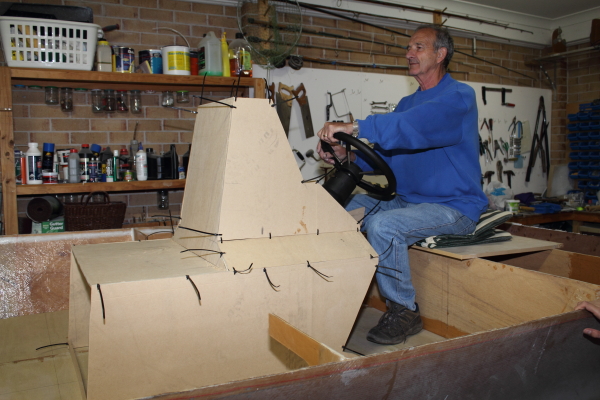Flat Chat 16





Flat Chat 16
Flat Chat 16
Australian slang for "Full Throttle" or "Pedal to the Metal", the Flat Chat 16 is a "flats" or shallow water fishing boat.
Designed for shallow water fishing, whether your into chasing Barra, Mangrove Jack, Reds, Trout or Snook, the Flat Chat 16 is designed to be equipped with the distinctive advantages for both saltwater and freshwater flats fishing.
Big on performance and all-around versatility, the Flat Chat 16's sleek, low profile design is designed to be quiet, controlled ease, even in windy conditions.
With her super shallow draft and extra dry ride mean the Flat Chat 16 is right at home whether you're fishing the saltwater estuaries or running a freshwater line on a nearby lake or river.
SPECIFICATIONS:
- LOA ……16ft (4.87m)
- BEAM ………7ft (2.13m) overall
- DRAFT/ hull only ………6″ (164mm) @ DWL
- Deadrise at transom ...… 6 degrees
- FUEL CAPACITY ....... 34.3 USG (130 Litres)
Horsepower… 90 Hp (max)
Outboard leg length.... L/S 20"
- LEVEL flotation (built as per the plans)
APPROX DRY TRAILER WEIGHT including a 90 hp motor…..1080 lbs
(490 kg ) depending on materials and outboard options* ( This includes a full tank of fuel)
- Construction …. Plywood Composite Construction
- Safety standards in compliance with the ABYC standard
- Structure is engineered in accordance with ABS class rules



Proudly Australian Designed
From the first sketch on the drafting board to the finished computer 3D modelling and CAD plans, every boat is designed in house by Mark Bowdidge (MRINA) himself.
After nearly forty years of building and designing boats, every design is specifically designed for Purpose, Performance, Seakeeping and Safety
Source: AUD @ Sun, 1 Jun.
FLAT CHAT 16 FEATURES
Just some of the features the Flat Chat 16 includes:
- Sleek yet simple and functional lines
- Shallow hull design for getting in amongst the mangroves and estuaries or fishing the flats.
- Centre console (side console optional)
- Side pockets for all your gear plus more
- Front casting deck for lure fishing plus easy access to the front locker and trolling motor when deploying
- Large 130 litre underfloor fuel tank
- Large storage compartments beneath the deck for storage of gear plus a large kill tank when fishing
- LEVEL flotation for compliance (we comply to the ABYC standards)
- Engineered to "Class" or Commercial shipping standards for those offroad or offshore fishing adventures.
- Easily handled by 1 person when trailering

Flat Chat 16 Frequently Asked Questions
What is included in the Flat Chat 16 Plans?
In regards to the Flat Chat 16 plans, it includes:
- 12 sheets in total (8 x A1 sheet size and 4 x A0 sheet size - full size bulkhead patterns)
- Full size patterns for bulkheads/ stem frame and transom
- Builders manual
- Bill of materials
- Numerous Build photo's for you to preview and assist with your build (A picture tells a thousand words" as the saying goes)
- Tip's and Tricks" e-book for building your boat
- Plus a lot more
Below is an example of the type of plans you receive

Is the Flat Chat 16 Builders Plate Compliant? (Australia/ USA/ Canada and the EU)
Yes.
We use the ABYC standard (https://abycinc.org/). (We do not use the AS 1799 standard, as we feel that this standard is full of "holes). Using the ABYC standard, all boats under 20ft MUST meet LEVEL flotation. It also means that the boat must meet certain stability criteria in regards to traverse stability, wind heeling criteria and max Hp allowed.
The Flat Chat 16, as designed exceeds the requirements for LEVEL flotation compliance. This covers the boat itself/ outboard/ people and cargo.
This standard is accepted worldwide. (Australia/ USA/ Canada and the EU)
We do not design our boats to meet BASIC flotation. To me, "Basic" flotation is dangerous.
Hope this helps

So what does the term "Ply/Composite" Construction mean?
So… what is Ply/ composite construction?
The term “composite means that if you use 2 or more materials in your construction layup, you must take into account for the mechanical properties of each material used. i.e. with Plywood and glass used we have to take into account for the materials Tensile strength/ Bending strength/ compression strength/ Shear strength and Modulus of Elasticity) in your engineering calculations. When you do this, its now "composite" construction.
Once it passes Tensile strength and bending strength for a particular area, we move to the next section. This method of engineering is applied throughout the whole boat.
Now… simply building a plywood boat and wetting out some glass on it is not composite construction. Its just a plywood boat with glass laid on.
All our Plywood and Strip plank designs are engineered as composites and in this regard, we engineer out boats to “Class” rules. In other words, we use Commercial ship standards. Here we use ABS or the "American Bureau of Shipping (https://ww2.eagle.org/en.html)
Here’s just one small area within one of our designs as an example of the calcs we do with all our designs.
I hope this helps
Mark Bowdidge (MRINA)



Can I get replace the ply/ composite structure with foam core?
No.
By doing so, your:
1/ Making the boat too light. This means the boat will float higher in the water, exposing the chines which in turn results in the moment of inertia of the waterplane being reduced which results in an unstable boat.
2/ Taking the weight out of the bottom of the boat also raises the overall centre of gravity which further adds to an unstable rolly boat. Why? Plywood has a density of approx. 600 kgm^3, whereas foam has a density between 80-240 kg/m^3 (pending foam core used). So in effect, you've taken out between 60% to 87% of the weight that's down low. Whoops. Now you have a serious problem with stability.
3/ The boat will become too "flighty" when on the plane.
BUILD THE BOAT AS PER THE PLANS and you won't have an issue.
Do you provide CNC cut files or kits?
No I do not.
So please don't ask, as refusal may offend

To see more of our Builders Testimonials and their boats, please click HERE















